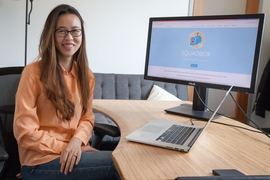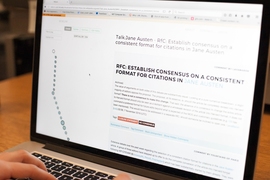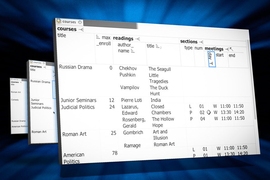"Inbox zero" often feels like the ultimate unattainable goal. You can spend hours organizing your email, and somehow a deluge of new messages will always emerge.
Since its origins in the 1970s, there’s been a longstanding desire to automate various aspects of email. Some might even recall the ’90s flirtation with “procmail”, which let authors write regular-expression scripts to sort their email into chosen folders.
While there’ve been several developments since then, the one-size-fits-all approach of apps like Gmail still leaves many users sifting, clicking, and separating until what can feel like the end of time.
Researchers from MIT’s Computer Science and Artificial Intelligence Laboratory (CSAIL) decided to dig deeper into people’s specific needs through a three-part study and new open-source tool that lets users write, test, and hone simple Python scripts for controlling incoming emails.
The team first led a workshop to identify categories of email needs, followed by a larger survey to deepen their understanding of the needs identified. They then looked at source code on Github to see types of automation needs that were important enough for email users to take into their own hands to address. Finally, the team used these findings to test a new tool they developed called “YouPS” (Your Postal Service).
The team found that over 40 percent of email users felt that their desired rules couldn’t be expressed using common email clients like Gmail or Outlook.
YouPS, which is still in a testing phase, lets users write more specific filter rules for incoming emails. Users can add multiple editor tabs, each related to a separate email mode, and they can also write different rules for each mode, so that their inbox behaves differently depending on the current one.
You might not want emails from a campus mailing list during a summer vacation, for example, or you might want the option of muting a pesky emailer who sent too many messages within a short period of time.
“Managing our inboxes in a such fine-grained manner with something like YouPS could eventually help give non-programmers the tools to manage their emails, and help save time for more intensive tasks or work,” says Soya Park, a PhD student at CSAIL and lead author of a new paper about the system.
Better data models wanted
For plenty of us, a flurry of emails during a tight deadline interrupts workflow and disrupts mental focus.
With that in mind, many users wanted filters that could capture “unseen” information that wasn’t in email headers or specifically labeled (i.e. sender or date). This included things like progress — pending or done — deadline, topic, priority, and task.
One potential filter could see that a message seems to require an action, and label it as “pending”, or tag a deadline if need be.
Filters could also be related to time of day, characteristics of the email thread — such as previous replies by a recipient, or number or rate of responses by others — and the state of the recipient (i.e. busy, in the office, on vacation).
Managing attention: notifications, modes, and context
MIT Professor David Karger says that standard email filters don’t give much in the way of flexibility. For example, some users disliked that these filters can’t be used for short periods of time or customized to the specific needs of the day.
Automatic filters also lack context for subtleties beyond what they’ve been trained on. Current email filtering rules are only based on metadata of incoming messages, such as if it’s from a specific sender or contains certain keywords. Users wanted to incorporate more context outside of the contents of a single message, like previous replies by a recipient, or number or rate of responses by others.
What’s more, with greater access to laptops, phones, and tablets, email has become an increasingly more expected “instant” way of communicating. To address this, users came up with rules for more tailored notification filters and temporary modes.
With YouPS, temporary modes, such as overnight “sleep modes” or daytime “work modes,” could be useful for those on specific schedules. For example, all “sleep mode” emails could be labeled “For Tomorrow,” while “work mode” emails could be labeled “To Do.”
Additional modes for things like vacations, conferences, or even evenings could have more specific rules to better fit the users’ needs. A user’s conference mode could have a rule that highlights only conference-related emails (i.e., meetups, announcements), or an “emotion” mode could kick in depending on a tired or anxious mood.
These more detailed filters all revolve around a broader goal of using a tool to better manage attention in a hyperconnected world.
Testing the tool
To get a sense of what programmers were already doing to make email more organized, the team went through GitHub to search for written scripts related to email and filters, and found that this complex processing made up at least 40 percent of the email scripts.
When finally using YouPS, users found that the extended email vocabulary was useful for scripting the rules users wanted, such as a way to write vacation auto-replies that could be sent to co-workers, but not family members.
In the future the team hopes to do a larger-scale deployment. They also plan to extend YouPS’ email automation capabilities to non-programmers by creating graphical user interfaces for expressing rules that use a much broader non-technical vocabulary.
“Email has a broad spectrum of users,” says Park. “A fixed interface for an email client simply can’t meet the diverse needs of many email users. The needs we found in these studies will guide future designers and developers of email clients and inbox management systems.”
“Many scripts for automating email were found on Github software archives, yet these automation techniques aren’t incorporated into common email clients”, says Susan Fussell, a professor of information science and communications at Cornell University who was not involved in the paper. “This suggests a need for a pipeline between the Github repository and ordinary email users, so that users know what scripts are there and how to use them — and one day be integrated into popular email clients.”
Park and Karger co-wrote the paper with PhD students Amy Zhang and Luke Murray. The team will present their paper in May at the Association for Computing Machinery Conference on Human Factors in Computing Systems in Glasgow, Scotland.









